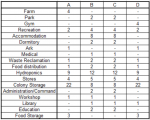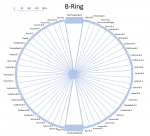-
Hi Guest!
The costs of running this forum are covered by Sea Lion Press. If you'd like to help support the company and the forum, visit patreon.com/sealionpress
You are using an out of date browser. It may not display this or other websites correctly.
You should upgrade or use an alternative browser.
You should upgrade or use an alternative browser.
The End and Afterwards
- Thread starter AndyC
- Start date
Recruitment Centres
During the recruitment interviews, the existence of the other recruitment centres is mentioned. For background, these are:
Europe
UK - London
UK - Edinburgh
France - Paris
France - Lyon
Germany - Berlin
Germany - Munich
Denmark - Copenhagen
Italy - Rome
Poland - Warsaw
Bulgaria - Sofia
USA
Los Angeles, CA
New York, NY
Washington DC
Phoenix, AZ
Denver, CO
Atlanta, GA
Canada
Vancouver
Ottawa
Mexico
Mexico City
Monterrey
Japan
Tokyo
Australia
Sydney
India
New Delhi
Somalia
Mogadishu
Brazil
Rio de Janeiro
Russia
Moscow
Iraq
Baghdad
The prevalence and distribution of the recruitment centres is largely driven by the levels at which funding is given to the Starship Foundation and geographical considerations/ease of travel to maximise their availability. Funding levels also drove the target crew contributions, although with adjustments made to try to widen availability worldwide (the aim being to get everyone from every country mentally invested). Originally they were targeted to be:
USA - 700
UK - 225
France - 225
Germany - 225
Canada - 100
Mexico - 100
India - 60
Japan - 50
Italy - 45
Brazil - 40
Russia - 40
Spain - 30
Australia - 30
Reunited Korea - 20
South Africa - 20
Somalia - 20
Austria - 15
Israel - 10
New Zealand - 10
Poland - 10
Portugal - 10
Sweden - 10
Norway - 10
Turkey - 10
Greece - 10
Romania - 8
Czech Republic - 6
Slovakia - 6
Bulgaria - 6
Denmark - 6
Asia, other than named countries - 30
Middle East, other than named countries - 20
South America, other than named countries - 20
Africa, other than named countries - 20
Baltic States - 12
Benelux countries - 8
These numbers changed as time went on, as Shelton tells Charlie. The eventual numbers were rather different from the target numbers.
During the recruitment interviews, the existence of the other recruitment centres is mentioned. For background, these are:
Europe
UK - London
UK - Edinburgh
France - Paris
France - Lyon
Germany - Berlin
Germany - Munich
Denmark - Copenhagen
Italy - Rome
Poland - Warsaw
Bulgaria - Sofia
USA
Los Angeles, CA
New York, NY
Washington DC
Phoenix, AZ
Denver, CO
Atlanta, GA
Canada
Vancouver
Ottawa
Mexico
Mexico City
Monterrey
Japan
Tokyo
Australia
Sydney
India
New Delhi
Somalia
Mogadishu
Brazil
Rio de Janeiro
Russia
Moscow
Iraq
Baghdad
The prevalence and distribution of the recruitment centres is largely driven by the levels at which funding is given to the Starship Foundation and geographical considerations/ease of travel to maximise their availability. Funding levels also drove the target crew contributions, although with adjustments made to try to widen availability worldwide (the aim being to get everyone from every country mentally invested). Originally they were targeted to be:
USA - 700
UK - 225
France - 225
Germany - 225
Canada - 100
Mexico - 100
India - 60
Japan - 50
Italy - 45
Brazil - 40
Russia - 40
Spain - 30
Australia - 30
Reunited Korea - 20
South Africa - 20
Somalia - 20
Austria - 15
Israel - 10
New Zealand - 10
Poland - 10
Portugal - 10
Sweden - 10
Norway - 10
Turkey - 10
Greece - 10
Romania - 8
Czech Republic - 6
Slovakia - 6
Bulgaria - 6
Denmark - 6
Asia, other than named countries - 30
Middle East, other than named countries - 20
South America, other than named countries - 20
Africa, other than named countries - 20
Baltic States - 12
Benelux countries - 8
These numbers changed as time went on, as Shelton tells Charlie. The eventual numbers were rather different from the target numbers.
Brilliant!View attachment 54
So something like this then?
Excuse the roughness of the model, sizing done scaling off the eye.
Yes, very much like that.
(Except that the modules are more cuboid than cylindtical)
I did guess that to be honest also cylinders are a lot easier to quickly draw in sketchup. I might do a better one if i am more bored and really want to avoid uni work.Brilliant!
Yes, very much like that.
(Except that the modules are more cuboid than cylindtical)
Artaxerxes
Senshi sautés seashells by the seashore
- Location
- #VALUE!
Brilliant!
Yes, very much like that.
(Except that the modules are more cuboid than cylindtical)
How do the shuttlebays work with that?
The Spine is cylindrical (and that's where the shuttle bays are); it's the modules on the Rings which are cuboid (primarily to aid design and maximise internal layout size).How do the shuttlebays work with that?
Yes!So like this, for one small module, approx 12.5x12.5x30m
View attachment 55
The small modules are 15m x 15m x 40m; the large ones are 45m x 45m x 120m.
Full dimensions are in this post here: https://www.alternatehistory.com/forum/threads/the-end-and-afterwards.354793/page-5#post-11017435
The spokes dimensions aren't given in that post - they're 3.5m corridors (width and height). Although the C-Ring spokes "step down" in size close to the Spine (at the distance out the other Ring spokes are when they intercept the Spine) to 2.3m in both dimensions. Each set of spokes has a "slip ring" around the Spine where they come in.
That's perfect!
Now that is great!
Thank you!
(literally the only difference left is that the diameter change on the spindle is angled rather than sharp (necessary for the shuttles to get out of the shuttle bays; they come out at an angle, clearing the later widening area) but that, I think, is a lot harder to be able to model and the accuracy of your model here is way beyond what I thought anyone would ever come up with)
Thank you!
(literally the only difference left is that the diameter change on the spindle is angled rather than sharp (necessary for the shuttles to get out of the shuttle bays; they come out at an angle, clearing the later widening area) but that, I think, is a lot harder to be able to model and the accuracy of your model here is way beyond what I thought anyone would ever come up with)
You're welcome, Yeah i didn't really do much work on the spindle.Now that is great!
Thank you!
(literally the only difference left is that the diameter change on the spindle is angled rather than sharp (necessary for the shuttles to get out of the shuttle bays; they come out at an angle, clearing the later widening area) but that, I think, is a lot harder to be able to model and the accuracy of your model here is way beyond what I thought anyone would ever come up with)
Shuttles:
The Endeavour carries three classes of shuttles: Type-C, Type-K, and Type-S. All three types are
Type-C shuttles are rated for 30 passengers or 15 tonnes to Low Earth Orbit; or carrying 20 tonnes down to the surface. Dimensions are 27m in length, 20 m in wingspan, and 10 m in height. It's not far off the dimensions of a Gulfstream G500, but with a wider body and rather different wings. I'm not an artist, so I've stolen a Skylon SSTO picture (it uses similar concepts) and hammered it hugely to fit:

The Endeavour has 10 Type-C shuttles, of which 3 have VTOL capability (originally 12, but it donated two, one VTOL one, to Endurance). Two of these are in theforward aft shuttle bay and the remaining 8 in the rear forward shuttle bay.
Type-K shuttles can carry sixty passengers (nominally) or 45 tonnes, or a combination of the two. They have a similar wingspan to the Type-Cs, but are longer and higher: 35m long, 25m wingspan, 15m height. Think of an elongated version of the Type-Cs, and more similar in size to the old Space Shuttle Orbiter. Endeavour has eight of these; 6 in the forward shuttle bay and the remaining 2 in the rear shuttle bay.

Type-S shuttles are the big beasts - not far off a Boeing 737 in dimensions. They carry 150 passengers, or 70 tonnes up to orbit, or can carry 100 tonnes down from orbit to landing. Again, based on the overall bodyplan above, but with a body about twice as wide and nearly twice as long: dimensions are 50m length, 35m wingspan, 15m height. All four of Endeavour's Type-S shuttles are in the forward shuttle bay.

The Endeavour carries three classes of shuttles: Type-C, Type-K, and Type-S. All three types are
Type-C shuttles are rated for 30 passengers or 15 tonnes to Low Earth Orbit; or carrying 20 tonnes down to the surface. Dimensions are 27m in length, 20 m in wingspan, and 10 m in height. It's not far off the dimensions of a Gulfstream G500, but with a wider body and rather different wings. I'm not an artist, so I've stolen a Skylon SSTO picture (it uses similar concepts) and hammered it hugely to fit:

The Endeavour has 10 Type-C shuttles, of which 3 have VTOL capability (originally 12, but it donated two, one VTOL one, to Endurance). Two of these are in the
Type-K shuttles can carry sixty passengers (nominally) or 45 tonnes, or a combination of the two. They have a similar wingspan to the Type-Cs, but are longer and higher: 35m long, 25m wingspan, 15m height. Think of an elongated version of the Type-Cs, and more similar in size to the old Space Shuttle Orbiter. Endeavour has eight of these; 6 in the forward shuttle bay and the remaining 2 in the rear shuttle bay.

Type-S shuttles are the big beasts - not far off a Boeing 737 in dimensions. They carry 150 passengers, or 70 tonnes up to orbit, or can carry 100 tonnes down from orbit to landing. Again, based on the overall bodyplan above, but with a body about twice as wide and nearly twice as long: dimensions are 50m length, 35m wingspan, 15m height. All four of Endeavour's Type-S shuttles are in the forward shuttle bay.

Last edited:
The shuttle bays themselves are cylindrical, measuring 56m across inside (and 65m across from the outside) for most of their length. The doors themselves are angled, otherwise the larger shuttles wouldn't be able to get out. The difference between the interior and exterior measurements, as well as allowing for the ship's hull, allow for passageways to and from the ships, which are routinely entered from the "top" and "bottom" of this picture:










